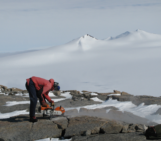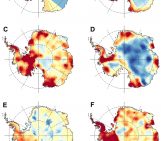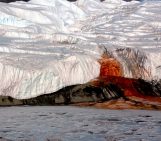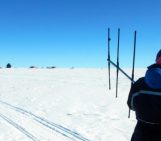
Fig. 1: A meteorite in the Szabo Bluff region of the Transantarctic mountain range, lying in wait for the 2012 ANSMET team to collect it [Credit: Antarctic Search for Meteorites Program / Katherine Joy].
Last week we celebrated Antarctica Day, 50 years after the Antarctic Treaty was signed. This treaty includes an agreement to protect Antarctic ecosystems. But what if, unintentionally, this protection also covered clues of life beyond Earth? In this Image of the Week, we explore how meteorites found in Antarctica are an important piece of the puzzle in the search for extraterrestrial life.
Meteorites in Antarctica
Year after year, teams of scientists from across the globe travel to Antarctica for a variety of scientific endeavours, from glaciologists studying flowing ice to atmospheric scientists examining the composition of the air and biologists studying life on the ice, from penguins to cold-loving microorganisms. Perhaps a less conspicuous group of scientists are the meteorite hunters.
Antarctica is the best place on Earth to find meteorites. Meteorites that fall in this cold, dry desert are spared from the high corrosion rates of warmer, wetter environments, preserving them in relatively pristine condition. They are also much easier to spot mainly due to the contrast between their dark surfaces on the white icy landscape (see our Image of the Week), but also because the combination of Antarctica’s climate, topography and the movement of ice serves to concentrate meteorites, as if lying in wait to be found.
The targeted search for meteorites has taken place annually since the late 1960s, leading to the recovery of over 50,000 specimens from the continent, and counting. The most prolific of these search teams is the US-led Antarctic Search for Meteorites ANSMET), which lay claim to over half of these finds. Comprising only a handful of enthusiasts, this team camps out on the slopes of the Transantarctic Mountains for around 6 weeks hunting for meteorites. The finds include rocks originating from asteroids, the Moon and Mars.
Evidence of life in a meteorite?
There has long been a link between meteorites and the potential for life beyond Earth. Perhaps the most famous, or rather infamous, meteorite found in Antarctica is the Alan Hills 84001 meteorite (ALH84001). Found by the 1984 ANSMET team, this meteorite was blasted from the surface of Mars some 17 million years ago as a result of an asteroid or meteorite impact, falling to Earth around 13,000 years ago. This piece of crystallised Martian lava is roughly 4.5 billion years old. The reason for its infamy is the widely publicised claim made a decade after its discovery that it harbours evidence of Martian life [McKay et al 1996]. Specifically, application of high resolution electron microscopy unearthed microstructures comprising magnetite crystals that looked, to the NASA scientist David McKay and his team, like fossilised microbial life, albeit at the nanoscale (see Fig. 2).

Fig.2: A nanoscale magnetite microstructure that was interpreted as fossilised microbial life from Mars [Credit: D McKay (NASA), K. Thomas-Keprta (Lockheed-Martin), R. Zare (Stanford), NASA].
Such a finding of evidence for extraterrestrial life has huge implications for the presence of life beyond Earth, a subject that has captivated humankind since ancient times. This extraordinary claim made headline news across the globe. It even gained acknowledgement by the then US president Bill Clinton. In the words popularised by Carl Sagan, “extraordinary claims require extraordinary evidence”, and this one garnered considerable controversy that endures today. At the time, there was no known process that did not involve life that could result in these types of structures. Subsequent research, triggered by this claim, has since indicated otherwise. The debate rolls on, and it seems we will never really know whether the crystals structures are fossils of Martian life or not, with no conclusive evidence on either side of the argument. Nevertheless, the interest and attention gained through this story kick-started a flurry of hugely successful Mars exploration missions, as well as reinvigorated the search for life beyond Earth.
Meteorites as microbial fuel
The ALH840001 is an unusual connection between meteorites and the search for extraterrestrial life. Much subtler, but more wide-reaching, is the potentially important connection between organic-containing meteorites and the existence of life elsewhere. The chondrite class of meteorites originates from the early solar system, specifically from primitive asteroids that formed from the accretion of dust and grains. They are the most common type of meteorite that falls to Earth, and contain a wide array of organic compounds, including nucleotides and amino acids, the so-called building blocks of life. In addition, a number of organic compounds that reside in these meteorites are also common on Earth, and are known to fuel microbial life by serving as a source of energy and nutrients for an array of microorganisms [Nixon et al 2012]. These meteorites have fallen to Earth and Mars for billions of years, since before the emergence and proliferation of life as we understand it. A significant quantity of these meteorites, and the organic matter contained within them, has therefore accumulated on Mars. In fact, owing to the thinner atmosphere of Mars, a larger quantity is expected to have accumulated there than on Earth, and with more of its organic content intact. It is a therefore a distinct possibility that these meteorites may play an important role in the emergence, or even persistence, of life on Mars, if such life has ever existed [Nixon et al 2013].
The search for life on Mars is very much an active pursuit. As we continue this search using robotic spacecraft, such as NASA’s Curiosity rover and the upcoming European Space Agency’s ExoMars rover, we seek to better define whether environments on Mars are habitable for life. But our understanding of habitability on Mars and beyond is defined by our knowledge of the limits of life here on Earth, such as the microbial lifeforms that can make a living on and under the Antarctic ice sheet (see this previous post), but also in terms of the chemical energy able to support life. The search for meteorites on Antarctica has an important role to play here, and long may the hunt continue.
References and further reading
- McKay, D.S., Gibson, E.K., Thomas-Keprta, K.L., Vali, H., Romanek, C.S., Clemett, S.J., Chillier, X.D.F., Maechling, C.R. and Zare, R.N. (1996): “Search for past life on Mars: Possible relic biogenic activity in Marian meteorite ALH84001“. Science 273: 924-930.
- Nixon, S.L., Cockell, C.S., Tranter, M. (2012): “Limitations to a microbial iron cycle on Mars“. Planetary Space Science 72:116-128.
- Nixon, S.L., Cousins, C.R., Cockell, C.S. (2013): “Plausible microbial metabolisms on Mars“. Astronomy and Geophysics 54:1.13-1.16.
- Blog post on The Science Behind Meteorites
- ANSMET website
- Article on the Importance of Antarctic meteorites
- Smithsonian Antarctic Meteorite Program website
- NASA’s Mars Exploration Program website
- ESA’s ExoMars Program website
Edited by Joe Cook and Clara Burgard
 Sophie Nixon is a postdoctoral research fellow in the Geomicrobiology group at the University of Manchester. She completed her PhD in Astrobiology in 2014 at the University of Edinburgh, the subject of which was the feasibility for microbial iron reduction on Mars. Sophie’s research interests since joining the University of Manchester are varied, focussing mainly on the microbiological implications of anthropogenic engineering of the subsurface (e.g. shale gas extraction, nuclear waste disposal), as well as life in extreme environments and the feasibility for life beyond Earth. Contact: sophie.nixon@manchester.ac.uk
Sophie Nixon is a postdoctoral research fellow in the Geomicrobiology group at the University of Manchester. She completed her PhD in Astrobiology in 2014 at the University of Edinburgh, the subject of which was the feasibility for microbial iron reduction on Mars. Sophie’s research interests since joining the University of Manchester are varied, focussing mainly on the microbiological implications of anthropogenic engineering of the subsurface (e.g. shale gas extraction, nuclear waste disposal), as well as life in extreme environments and the feasibility for life beyond Earth. Contact: sophie.nixon@manchester.ac.uk




